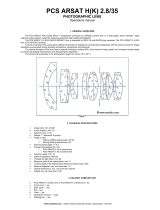
www.hasselblad.com
TILT AND SHIFT ADAPTER
The revolutionary HTS 1.5 is a tilt and shift
adapter that can provide a pivotal step-up for
many Hasselblad photographers. Designed for
the HCD28mm, HC35mm, HC50mm, HC80mm
and the HC100mm lenses it, in effect, adds ve
different “tilt and shift lenses” to the range.
With the extension tubes, H13, H26 or H52, the
HTS 1.5 can also be used for close-up work.
This simple device solves not only technical
challenges, but also provides exciting opportuni-
ties for creative solutions as well. The combina-
tion of well-known optical principles combined
with the latest in digital image control, provides
a powerful package that will expand photo-
graphic expression to new levels.
Hasselblad holds a patent pending on the
HTS 1.5.
“Shift” is the moving of a lens, up and down or to the sides, from
its central position while retaining its perpendicular orientation to
the lm plane. Simply put, the adapter expands the diameter of the
projected image circle at the lm plane. This allows for much greater
freedom in “placing” the image area within the now much broader
circle before vignetting takes effect. And most importantly, all this
happens without moving the orientation of the camera in relation to
the subject. So if verticals, for example, are acceptable in the view-
nder, they will remain so whatever the amount of shift to include
the “hidden” parts of the image. Simple but ingenious.
“Tilt” differs from shift in that the normal perpendicular orienta-
tion of the lens to the lm plane is changed resulting in a change
in the plane of focus. This means that at any given aperture/focus
setting, the depth of eld in the subject will not remain as simply
the space between two measured points from the camera as is
normally the case, but increased or decreased. This amount is user
controlled. Once again, simple but ingenious.
By combining these two laws of physics, the doors of creative
solutions are thrown wide open. The list of situations that could
advantageously exploit tilt and shift is probably longer than it might
rst appear to be. For some professional photographers it could
rapidly become an essential item for all work.
But the story doesn’t end there. Large-format users have been
using tilt and shift for many years, partly because they could, but
partly because they had to. Some photographic solutions unfor-
tunately, have also created problems, lens edge performance,
for example, being one of them. The dilemma that arose forced
photo graphers to nd a compromise, between the “illness” and the
“cure”. Hasselblad has now eradicated this dilemma.
With the introduction of automatic chromatic aberration correc-
tion computation (DAC), signicant improvements strike the viewer
immediately. All calculations and adjustments take place in the
background monitored and governed by sensors in the adapter. The
sharpness at the edge of the frame, despite the fact that the lens
is pushed to its limits, remains stunning.
On the creative front, it has long been standard practice for
photo graphers to break the rules in order to produce images that
show something just a little different. Large-format users were
well-acquainted with the imaginative possibilities that arose from
making the “wrong” camera or lens movements. And now Hassel-
blad users can enjoy this stimulating freedom as well. Fascinating
and captiva ting images are easily conjured up and controlled with
just a few slight movements. The combination of large sensors and
razor sharp lenses – and now tilt and shift possibilities – Hassel-
blad has brought some of the creative aspect of former large-format
world to the digital medium format.
Take a look at this revolutionary accessory at your nearest
Hasselblad dealer. Try it yourself out to see how this new product
could rapidly become an essential part of your photography toolkit.
The powerful combination of tilt, shift and DAC can bring new per-
spectives to your photographic vision and provide a marked change
in both the technical and creative aspects of your work.














